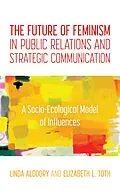Linda Aldoory and Elizabeth L. Toth present an innovative socio-ecological model for understanding and building a feminist future for public relations practices. This approach acknowledges previous gaps in scholarship and practice caused by ideological, societal, mediated, and organizational factors constructing norms and expectations for gender, race, and class.
Autorentext
Linda Aldoory is professor of communication and associate dean for research in the College of Arts and Humanities at the University of Maryland. She is also affiliate faculty member of the Department of Women's Studies and has been doing research on gender and feminism in public relations for over 20 years.
Elizabeth Toth is professor of communication at the University of Maryland and former chair of the department. She is also an affiliate faculty member of the Department of Women's Studies.
Klappentext
Aldoory and Toth present a socio-ecological model for understanding and building a feminist future public relations. This approach acknowledges previous gaps in scholarship and practice caused by ideological, societal, mediated, and organizational factors constructing norms and expectations for gender and race.
Inhalt
Section 1: Overview of the Book: Model and Definitions
Chapter 1: A Socio-Ecological Model for Public Relations and Strategic Communication
Chapter 2: The Backstory: Conceptualization and History of Public Relations and Feminism
Section 2: Ideological Level: Social Norms, Hegemony, and Media
Chapter 3: Ideological Level: The Overarching Power of Hegemony and Social Norms
Chapter 4: Media Level: Symbiotic yet Contested Terrain
Section 3: Organizational Level: Issues and Theories
Chapter 5: Organizational Level: Their Role in Maintaining the Status Quo
Chapter 6: Organizational Level: Facilitating Inequity and Marginalization
Section 4: Professional Level: Discursive Legitimacy and Professional Associations
Chapter 7: The Professional Level: Questions of Legitimacy and Value
Chapter 8: Professional Level: Interrogating Difference in Professional Associations
Section 5: Practitioner Level: Lived Experience and Identity
Chapter 9: The Practitioner Level: The Lived Experiences of Same and Difference
Chapter 10: Practitioner Level: Theory-Driven Approaches to Understanding Identity
Section 6: Dialogue and Future Directions
Chapter 11: Dialogue with Scholars and Practitioners: Co-constructing Meaning of the Model
Chapter 12: Putting the Socio-Ecological Model to Use
